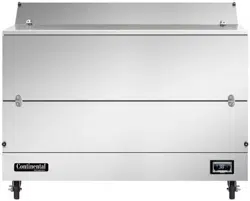Loading ...
Loading ...
Loading ...

4
MILK COOLERS FORCED AIR & COLD WALL
OPERATIONS MANUAL
IMPORTANT NOTE: For maximum efficiency, your new
cabinet must be located where an unrestricted air supply
can be circulated to the condensing unit. For optimum
performance, a minimum clearance of 3” on each side
and rear of the cabinet should be provided. Your model
has been designed to operate only with the casters sup-
plied. Never obstruct the area below the grill in the front
or rear of the cabinet in any way, and never place or store
anything inside the cabinet machine compartment. These
rules are essential for long life. FAILURE TO FOLLOW
THESE GUIDELINES MAY VOID YOUR WARRANTY.
FLOOR DRAINS AND LOADS
Your milk cooler should be located over top of, or close to, a
building floor drain. The floor should provide level positioning,
be free of vibration and strong enough to support the total com-
bined weights of your new model plus the maximum product
load which might be placed into it. Keep in mind that all the
weight is concentrated at the casters. To estimate the possible
product weight, assume that each cubic foot of storage space
weighs approximately 35 pounds. Multiply 35 pounds by the
amount of cubic feet in the cabinet to obtain the product load
weight.
For example, a 20 cubic foot refrigerator can hold approximately 700
pounds of product (35 x 20). Assuming the cabinet itself weighs 300
pounds, the total combined weight of cabinet and product is approxi-
mately 1000 pounds. Therefore, the floor in this example must be able
to support up to 1000 pounds.
CABINET CLEAN OUT DRAIN AND HOSE
All forced air and cold wall models contain a 1” diameter clean
out drain with a drain stopper and 3’ long ¾” ID drain hose. The
floor drain is located on the bottom right hand floor in the stor-
age compartment. The external drain connection and hose are
accessible behind either the front or rear grill (see Figure 3 for
location). A flexible hose, attached to the drain line under the
cabinet, is located behind the front grill, toward the right hand
side (see Figure 3). The clean out drain hose should be routed
directly to a building floor drain. Never place the hose in the con-
densate pan of your milk cooler. The hose must be positioned
safely so any liquid flows directly into the floor drain and does
not spill onto the floor, to avoid any tripping or slipping hazards.
your cabinet to prevent damage. After moving unit to its final
location, remove all the staples from around the bottom of the
crate using a pry bar. Slide the cardboard carton up and off
the unit, being careful not to rub against the cabinet. Remove
any accessories or boxes on the skid. Dispose of all packaging
materials properly.
Your milk cooler comes with the casters pre-installed. Two
(2) bolts secure the cabinet to the wooden skid. The bolts are
located at each end on the underside of the cabinet. Using a ¾”
socket or open end wrench, remove the bolts. You can now lift
the cabinet off the skid, or carefully knock the wood supports off
each end of the skid and roll your milk cooler off.
IMPORTANT NOTE: Do not under any circumstances, lay
your new model on its front or sides. For a brief period
of time, you may lay the cabinet on its back, but only
when it’s properly blocked so as not to crush the back
or end panels and also to allow provision for your hands,
in order to set it in its upright position without damaging
the cabinet. Do not plug in and operate model for at
least three (3) hours after cabinet is set upright from
being on its back as this can damage the compressor.
INSTALLATION AND LOCATION
Before moving the cabinet to its final point of installation, mea-
sure all doorways or passages to assure sufficient clearance.
VENTILATION
The final location site of your forced air or cold wall refrigerator
must provide a sufficient quantity of cool, clean air. All refrigera-
tion systems operate more efficiently and trouble-free with cool,
dry air circulation. Avoid locations near heat and moisture gen-
erating equipment including ovens, fryers, dishwashers, steam
kettles, etc. Do not install in direct sunlight (where temperatures
may exceed 100°F) or in an unheated area (where temperatures
may drop below 55°F).
Air supply to the condensing unit is critical. Restricting airflow
places excessive heat load on the unit, adversely affecting its
operation and may cause premature failure.
Loading ...
Loading ...
Loading ...
